- home
- BAKERECIPES
BakeRecipes
Bringing real baking into your home with deliciously simple recipes.
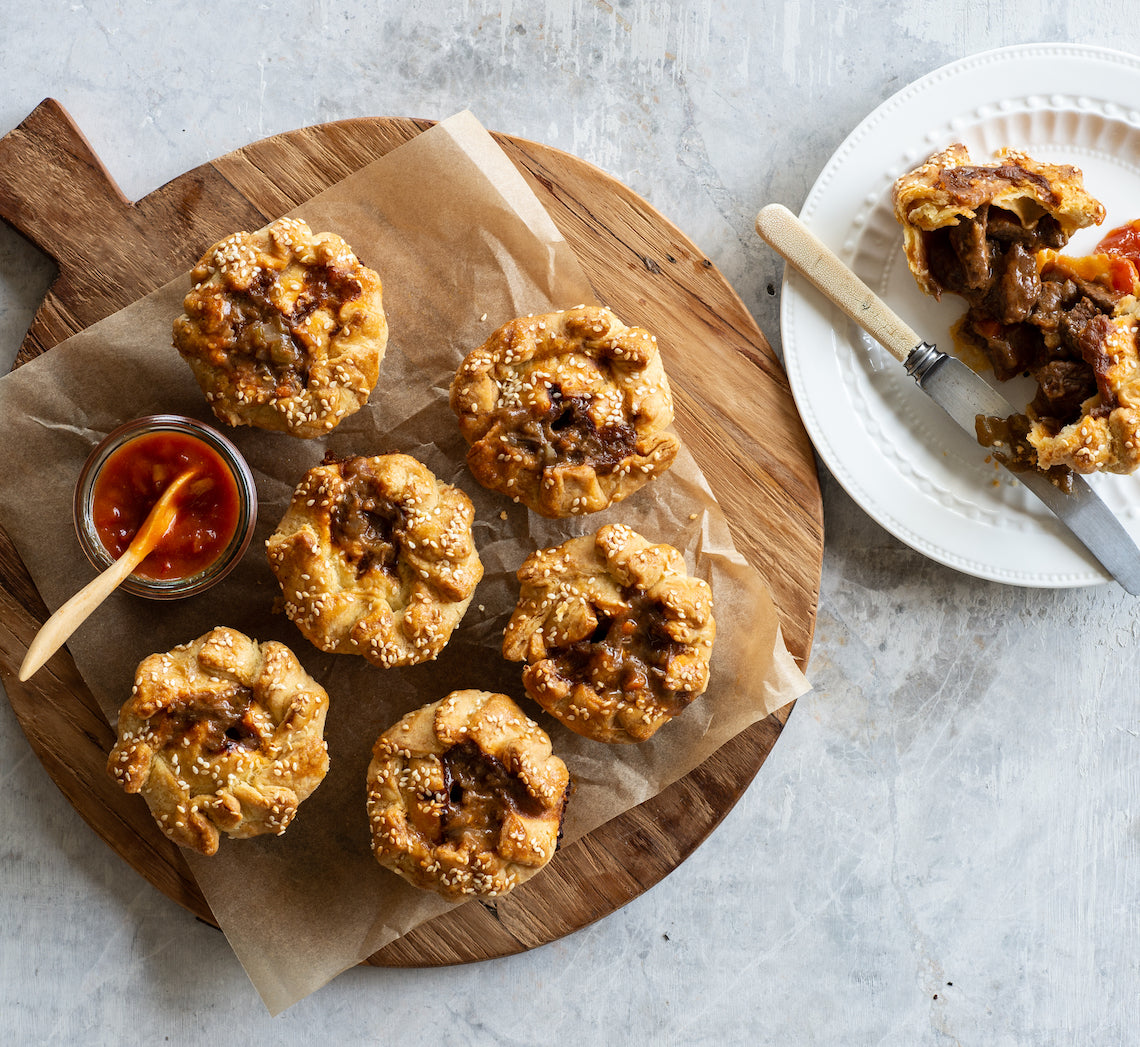
Prep 1hr (+ 2hr cooling and pastry making time)Bake 45-50minMakes 12 small pies
Meat pies are the quintessential Aussie bakery favourite... But they are even better when homemade!
Ingredients
3 quantities Basic Shortcrust Pastry, each quantity shaped into a disc before wrapping and chilling as directed
1 egg, lightly whisked
Sesame seeds, to sprinkle (optional)
Filling
35g (1¼ oz/¼ cup) plain flour
Salt and freshly ground black pepper, to taste
1kg (2lb 3oz) trimmed chuck steak, cut into 2cm (¾in) pieces (see Baker's Tips)
60ml (2fl oz/¼ cup) olive oil
1 large brown onion, chopped
1 celery stalk, trimmed and diced
1 carrot, peeled and diced
2 garlic cloves, finely grated or chopped
1 tablespoon tomato paste
250ml (9fl oz/1 cup) good-quality beef stock
500ml (17fl oz/2 cups) water
1 tablespoon Worcestershire sauce
Method
- Season the flour with salt and pepper. Place in a large bowl with the diced steak and toss to coat.
- Heat 1 tablespoon of the oil in a large heavy-based saucepan over a high heat and cook half the diced steak, stirring occasionally, for about 5 minutes or until sealed. Remove from the pan, scraping any cooked-on bits from the base, and set aside. Repeat with another tablespoon oil and the remaining steak.
- Clean the pan. Add the remaining 1 tablespoon oil, onion, celery and carrot and cook over a medium heat, stirring occasionally, for 10 minutes or until the onion starts to soften. Add the garlic and cook for a further 1 minute, stirring occasionally, or until aromatic. Add the tomato paste and cook, stirring for 1 minute. Return the steak to the pan with the stock, water and Worcestershire sauce and bring to a simmer.
- Reduce heat to low, cover with a piece of baking paper and simmer, covered, for 1 hour, stirring occasionally. Uncover and then simmer for a further 1 hour, stirring frequently or until the meat is tender and the liquid has reduced to a thick sauce consistency. Transfer the mixture to a heatproof bowl, cover loosely and place in the fridge, stirring occasionally, until cooled to room temperature (this will take about 2 hours).
- When ready to assemble the pies, preheat oven to 200°C/400°F (180°C/350°C fan-forced). Unwrap one of the pastry discs and place on a lightly floured, cool bench top. Use a lightly floured rolling pin to roll the pastry disc until about 3mm (1⁄8 in) thick. Use a 14cm (5½in) pastry cutter, saucer or upturned bowl as a guide to cut out 6 rounds, re-rolling any leftover pastry if necessary. Gently ease the pastry discs into the holes of an ungreased 12-hole 80ml (2¾fl oz/1⁄3 cup) muffin tray to line six holes. Use your fingertips to press it gently into the corners without stretching it – the pastry will reach above the top of the muffin pans and buckle slighlty. Repeat with another pastry disc to make 12 pastry cases in total. Divide the steak mixture between the pastry cases to fill (you may have a little mixture left over).
- Roll out the remaining pastry to about 3mm (1⁄8in) thick and use a 7cm (2¾in) round pastry cutter to cut out 12 lids. Use a small sharp knife to cut a small steam hole in the centre of each round (see Baker’s Tips). Place a lid over the mixture to cover each pie, brush each lid with the whisked egg and then fold the excess pastry from the bases over the top of the lids, crimping and pressing together to seal. Brush the top of each pie with some more of the remaining egg wash and sprinkle with sesame seeds, if using.
- Bake the pies in preheated oven for 45-50 minutes or until the pastry is cooked through and golden. Stand the pies in the tin for 5 minutes before turning out and serving.
Baker's Tips
- You will need about 1.5kg untrimmed chuck steak for this recipe.
- You can also make the steam holes in the pastry lids by using a 1cm piping nozzle to cut a hole in the centre of each lid before placing it on top of the pies.
- These pies will keep in an airtight container in the fridge for up to 2 days. Reheat in an oven preheated to 160°C/315°F (140°C/285°F fan-forced) for 10-15 minutes or until heated through.
- To freeze, wrap individually in plastic wrap and then seal in an airtight container or freezer bag and freeze for up to 3 months. Thaw in the fridge before reheating (see above tip).
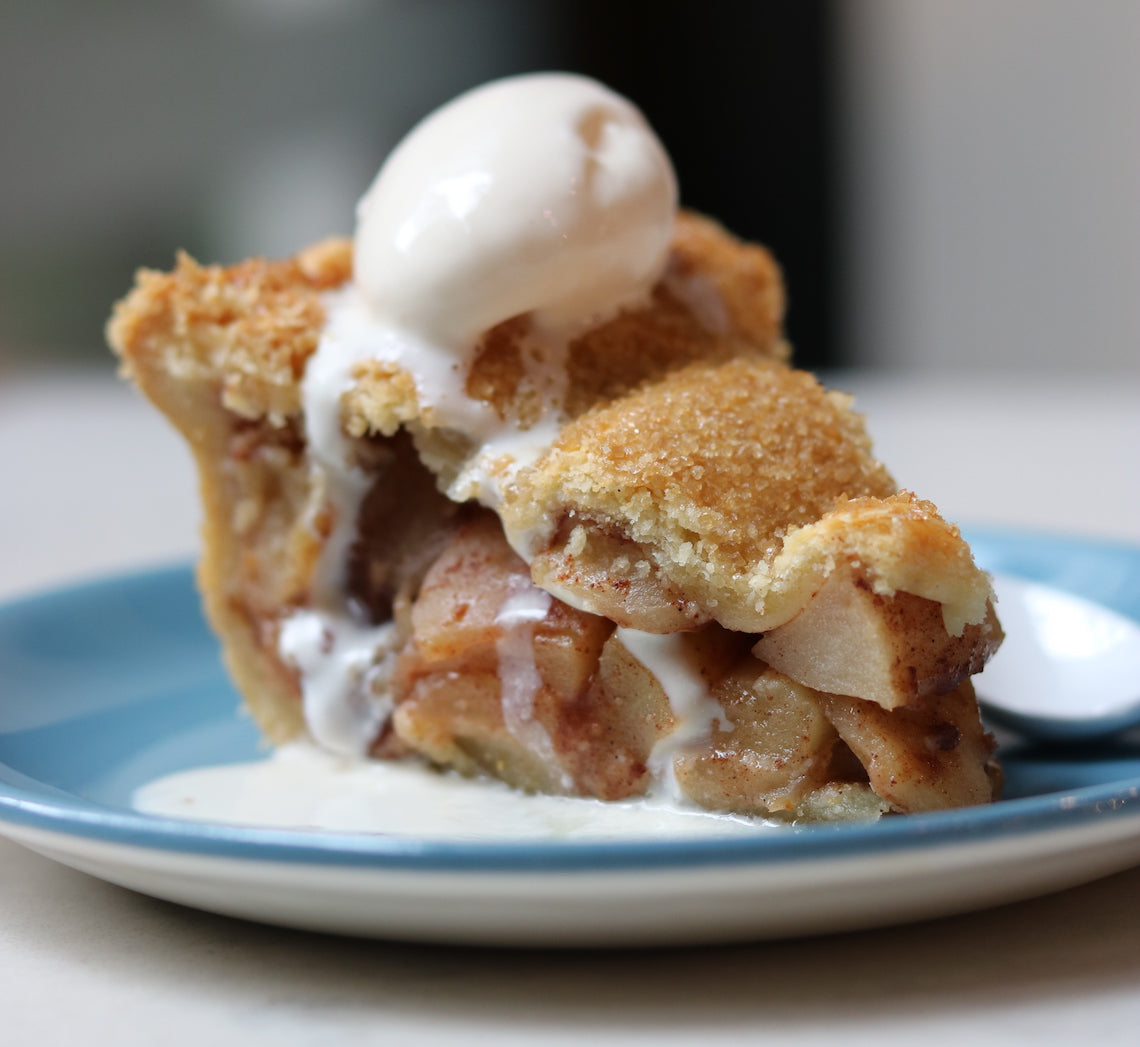
Prep 15min (+chilling time)
Shortcrust pastry, when you have a good recipe, is one of the simplest and quickest pastries to make. This sweet vanilla variety is great with a Classic Apple Pie.
Ingredients
200g (1⅓ cups) plain flour
2 tablespoons almond meal
2 tablespoons caster sugar
150g chilled salted butter, cubed
3 tablespoons iced water
1 teaspoon vanilla bean paste
Method
- Combine the flour, almond meal and caster sugar in the bowl of a food processor. Add the butter and use the pulse button to pulse until the mixture resembles fine breadcrumbs.
- Remove the lid of the food processor and sprinkle the water over the flour mixture and then add the vanilla bean paste. Continue to process using the pulse button until the mixture is evenly combined and just starts to come together (but hasn’t as yet formed a ball). The pastry should be soft but not sticky.
- Turn the pastry out onto a lightly floured, cool bench top. Knead lightly with your fingertips for about 10 seconds or until it comes together but isn’t completely smooth. Shape the pastry into a disc, wrap well in plastic wrap, and chill and use as directed.
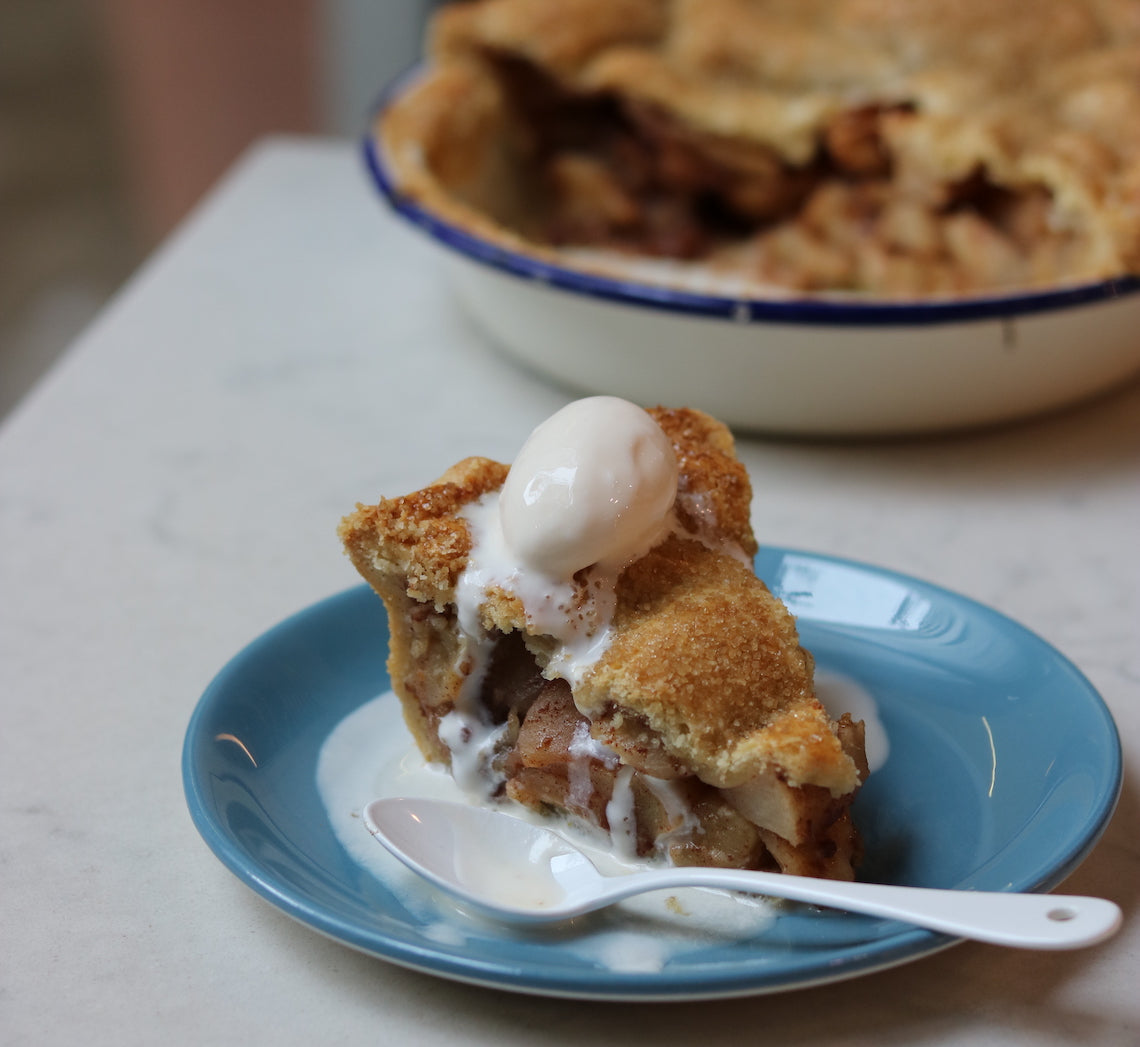
Prep 30min (+pastry making time)Bake 1hr15minMakes 8-10 serves
Everyone loves a classic apple pie – it is the ultimate comfort food... Especially when teamed with some good vanilla ice cream!
Ingredients
2 quantities Sweet Vanilla Shortcrust Pastry (combine ¼ of one pastry quantity with the other, and then shape each into a separate disc before wrapping and chilling for 30 minutes)
1 egg yolk
2 teaspoons milk
1 tablespoon demerara sugar
Vanilla ice-cream, to serve
Apple Filling
2½ tablespoons caster sugar
1½ tablespoons plain flour
1½ teaspoons ground cinnamon
6 medium (about 140g each) pink lady or granny smith apples
1 orange, rind finely grated and juiced
1 teaspoon vanilla bean paste
25g (¼ cup) almond meal
20g salted butter, finely diced
Method
- Preheat the oven to 200°C (180°C fan-forced).
- Unwrap the larger portion of pastry and place on a lightly floured, cool benchtop. Use a lightly floured rolling pin to roll the pastry into a round, about 5mm thick and about 35cm in diameter.
- Carefully drape the pastry loosely around the rolling pin, place it over an ungreased 20cm (top measurement) metal or ceramic pie dish (see Baker’s Tips) then unroll the pastry being careful not to stretch it. Gently lift the edges of the pastry and ease it into the pie dish to line the base and the sides and settle it into the corners without stretching it, allowing the excess pastry to overhang the edges. Place the lined pie dish on an oven tray and then place in the fridge to rest for while making the filling.
- To make the apple filling, combine the sugar, flour and cinnamon in a small bowl. Peel, core and quarter each apple. Cut each apple quarter into 4 wedges and place in a separate large bowl with the orange rind, 1 tablespoon of the orange juice and the vanilla bean paste. Use your hands or spatula to toss gently to evenly coat the apple slices. Add the sugar mixture and toss gently to combine evenly.
- Sprinkle the almond meal over the base of the chilled pastry case, spoon the apple mixture over the top and dot with the diced butter. Whisk together the egg yolk and milk. Brush the edge of the pastry with the egg wash. Roll out the remaining smaller disc of pastry into a round, about 5mm thick and about 25cm in diameter. Use a 2cm fluted or plain round cutter to cut out a circle from the centre of the pastry. Carefully drape the pastry loosely around the rolling pin and roll over the top of the pie. Use your fingertips to press the pie pastry top and bottom together around the edge of the pie to seal. Use a small sharp knife to trim the excess pastry from around the edge. Use your fingertips to pinch the edge of the pastry to decorate. Brush the top of the pie with some of the remaining egg wash and then sprinkle with demerara sugar.
- Bake in preheated oven for 30 minutes. Reduce the oven temperature to 160°C (140°C fan-forced) and bake for a further 40 minutes or until the pastry is golden and cooked through and the apples are tender (see Baker’s Tips). Remove the pie from the oven and stand for 5 minutes before serving warm with ice cream.
Baker's Tips
- For this recipe you will need a ceramic or metal pie dish measuring about 20cm across the top, 17cm across the base and 4.5cm deep.
- To check if the apples are tender, insert a skewer into the centre of the pie.
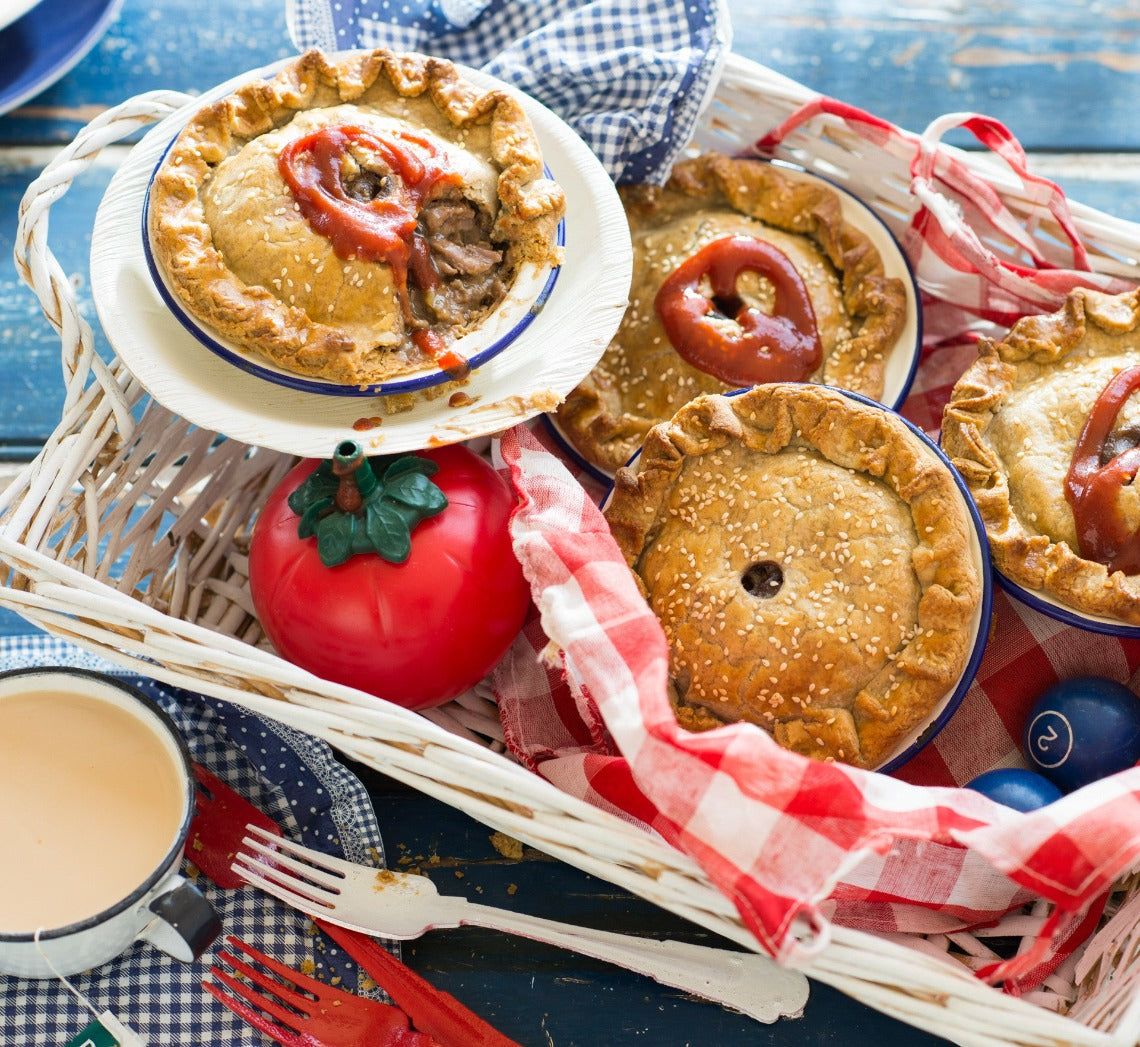
Prep 1hr (+2hr cooling and 5min standing time)Bake 2hr 30minMakes 6 serves
The addition of allspice, shiitake mushrooms, ginger and oyster sauce give these good old Aussie pies a subtle, but truly delicious, Chinese twist.
Ingredients
3 quantities shortcrust pastry (each with the addition of 1 teaspoon ground allspice added with the flour), each made separately and shaped into a disc before wrapping and chilling (see Baker's Tips)
1 egg, lightly whisked
sesame seeds, to sprinkle
Filling
1kg trimmed chuck steak, cut into 2cm chunks
35g (¼ cup) plain flour
60ml (¼ cup) peanut oil
2 small brown onions, chopped
200g shiitake mushrooms, sliced
2 garlic cloves, finely chopped
3 teaspoons finely grated ginger
250ml (1 cup) good-quality beef stock
500ml (2 cups) water
2 tablespoons oyster sauce, or to taste
Method
- Place the chuck steak in a large bowl, sprinkle with the flour and toss to coat.
- Heat 1 tablespoon of the oil in a large heavy-based saucepan over a high heat and cook half the steak chunks, stirring occasionally, for about 5 minutes or until sealed. Remove from the pan, scraping any cooked-on bits from the base, and set aside. Repeat with another tablespoon oil and the remaining steak.
- Clean the pan if necessary. Add the remaining 1 tablespoon oil, onion and shiitake mushrooms and cook over a medium-high heat, stirring occasionally, for 5 minutes or until the onion and mushrooms start to soften. Reduce the heat to medium, add the garlic and ginger and cook for a further 1 minute, stirring occasionally, or until aromatic. Return the steak to the pan with the stock, water and 1 tablespoon of the oyster sauce and bring to a simmer.
- Reduce heat to low and simmer, covered, for 30 minutes, stirring occasionally. Uncover and then simmer for a further 30 minutes to 1 hour, stirring frequently or until the meat is tender and the liquid has reduced and thickened to a thick sauce consistency. Stir in the remaining oyster sauce, taste and adjust seasoning by adding a little more oyster sauce if necessary. Transfer the mixture to a heatproof bowl, cover and place in the fridge, stirring occasionally, until cooled to room temperature (this will take about 2 hours).
- When ready to assemble the pies, preheat oven to 220°C (200°C fan-forced). Brush 6 x 10.5cm (base measurement) x 14cm (top measurement) metal or foil pie dishes. Unwrap the pastry discs and divide each into quarters. Shape a quarter into a disc and use a lightly floured rolling pin to roll the pastry on a lightly floured bench top into a round until about 3mm thick and about 15cm in diameter. Repeat with the remaining discs. Use an upturned pie dish to cut out pie lids from 6 of the rolled pastry rounds. Use the end of a 1cm piping nozzle or a small sharp knife to cut a small steam hole in the centre of each pie lid.
- Gently ease the the uncut pastry discs into the pie dishes and use your fingertips to press the pastry gently into the corners without stretching it — it will overhang the dishes slightly. Divide the steak mixture between the pastry cases to fill. Place a lid over the mixture to cover each pie, brush the edge of each lid with the whisked egg and then fold the excess pastry from the bases over the top of the lids, crimping with your fingertips or pressing with a fork together to seal. Brush the top of each pie lightly with some of the remaining egg wash and sprinkle with sesame seeds.
- Reduce the oven to 200°C (180°C fan-forced) and bake the pies in preheated oven for 45-50 minutes or until the pastry is cooked through and a deep golden. Stand the pies in the dishes for 5 minutes before turning out and serving.
Baker's Tips
- Don't be tempted to make the 3 quantities of pastry all at once. Making them separately makes the pastry easier to handle and will give you a better final result.
Photography by Alan Benson.Save

Prep 20minBake 17-20minMakes about 24
Ingredients
1 quantity Shortcrust Pastry, divided into 2 portions before wrapping and chilling
Filling
1½ rashers bacon, trimmed and finely choppedMethod
- With a lightly floured rolling pin, roll out one portion of pastry on a lightly floured surface until about 2mm thick. Use a 7cm round cutter to out 12 circles and then carefully ease them into an ungreased 12-hole mini (1½ tablespoon capacity) muffin tray, pleating the pastry 4-5 times to help shape it. Repeat with the remaining pastry and another 12-hole mini muffin tray to make 24 tartlet cases in total. Use a fork to prick the base of each tartlet case twice. Place the muffin trays in the freezer for at least 30 minutes or until ready to bake.
- Preheat oven to 200°C (180°C fan-forced).
- Meanwhile, to make the filling, cook the bacon in a non-stick frying pan over medium heat for 5 minutes, stirring occasionally, or until starting to crispen. Transfer the bacon to a medium bowl and add the cheese and parsley. Whisk together the egg and cream, add to the bacon mixture and stir with a fork to combine. Season with pepper.
- Bake the unfilled frozen tartlet cases straight from the freezer in preheated oven for 12 minutes or until golden.
- Use a teaspoon to fill each pre-baked tartlet case with a small amount of the the filling, making sure you get a good amount of the bacon, cheese and egg mixture in each. Return to the oven and bake for 5-8 minutes or until the filling is just set.
- Serve warm or at room temperature garnished with a tomato slice, if desired.
Baker's Tips
- You can make these tartlets up to 2 days ahead of serving. Cool and then store in an airtight container in the fridge. Place the tartlets back in the tins before reheating in an oven preheated to 160°C (140°C fan-forced) for 10 minutes or until heated through.
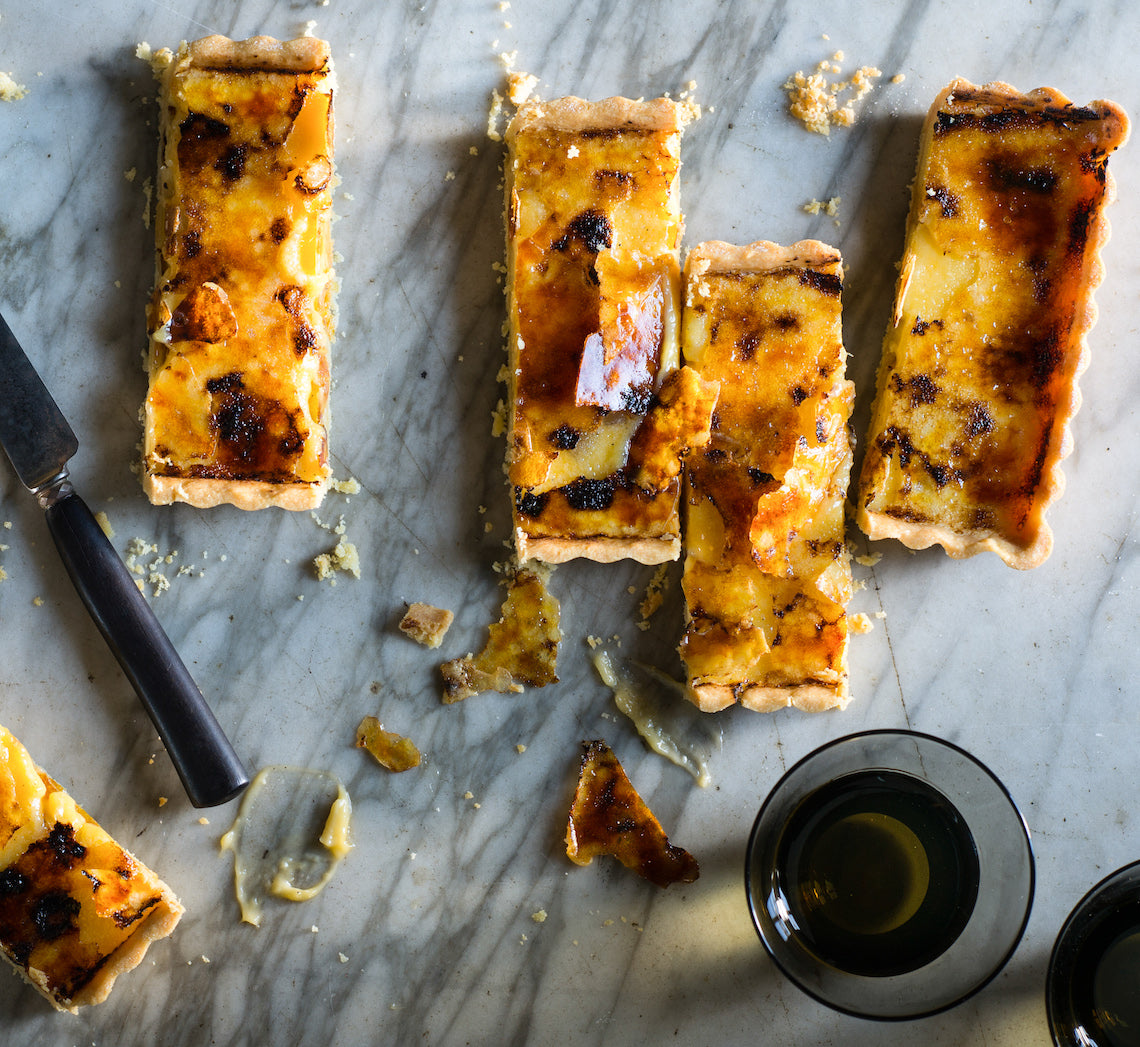
Prep 25min (1hr cooling time)Bake 60-65minMakes 8 serves
Spiked with chunks of crystalised ginger this luscious crème brûlée custard makes a divine tart filling. I have to confess, that this is one of my all-time favourite desserts!
Ingredients
1 quantity sweet shortcrust pastry
50g ( 1¾oz) crystalised ginger, cut into small pieces (about 8mm/3/8in)
2 tablespoons cater sugar, to sprinkle
Crème Brûlée Filling
250ml (1 cup/9fl oz) pouring cream
1 vanilla bean, split lengthways and seeds scraped
3 egg yolks, at room temperature
55g (¼ cup/2oz) caster sugar
Method
- Preheat oven to 200°C/400°F (180°C/350°F fan-forced). Use a lightly floured rolling pin to roll out the pastry on a lightly floured bench top to a rectangle about 3mm/ ⅛in thick. Carefully drape the pastry loosely around the rolling pin. Place it over an ungreased 2.5cm/1in deep, 34.5cm x 11.5cm (13½in x 4½in), base measurement, tart tin with a removable base and then unroll the pastry being careful not to stretch it. Gently lift the edge of the pastry and ease it into the tart tin to line the base and sides and settle it into the corners. Use your fingertips to press it gently into the corners without stretching it. Then, working around the tin, press the pastry into the side using your thumb or finger. Roll the rolling pin over the top of the tart tin to trim any overhanging pastry.
- Place the tart tin on an oven tray. Prick the pastry base with a fork about 12 times. Line the pastry case with crumpled baking paper or foil and fill with pastry weights, or raw rice, making sure they press into the corners. Bake in preheated oven for 20 minutes.
- Remove the pastry case from oven and use the paper or foil to carefully lift the weights out of the case. Return to the oven and bake for a further 20 minutes or until golden and cooked through.
- Meanwhile to make the Crème Brûlée Filling, combine the cream and vanilla bean and seeds in a medium saucepan and bring almost to a simmer over medium heat. Remove from heat and set aside. Use a balloon whisk to whisk together the egg yolks and sugar until well combined. Gradually stir in the hot cream mixture (don’t over-mix – you don’t want it to be frothy). Strain the custard into a heatproof jug.
- Remove the tart case from the oven and reduce the oven temperature to 160°C/315°F (140°C/285°F fan-forced). Sprinkle the base evenly with the ginger and then pour the warm custard immediately into the hot tart case. Carefully return to the oven and bake for a further 20-25 minutes or until the custard is just set and it still wobbles slightly in the centre when the tin is shaken gently.
- Remove the tart from the oven and set aside on a wire rack for at least 1 hour or until cooled to room temperature.
- To serve, sprinkle the top of the tart evenly with the sugar and use a blowtorch to caramelise the sugar until a deep golden. Stand for 5 minutes for the toffee to set before serving.
Baker's Tips
- This tart will keep in an airtight container in the fridge for up to 2 days. Stand at room temperature for 30-60 minutes to bring back to room temperature before serving. The pastry will soften slightly on storing.
This recipe is from Anneka's SBS Food online column, Bakeproof: Comforting Custard.
CLICK HERE for more Bakeproof recipes.
Photography by Alan Benson.
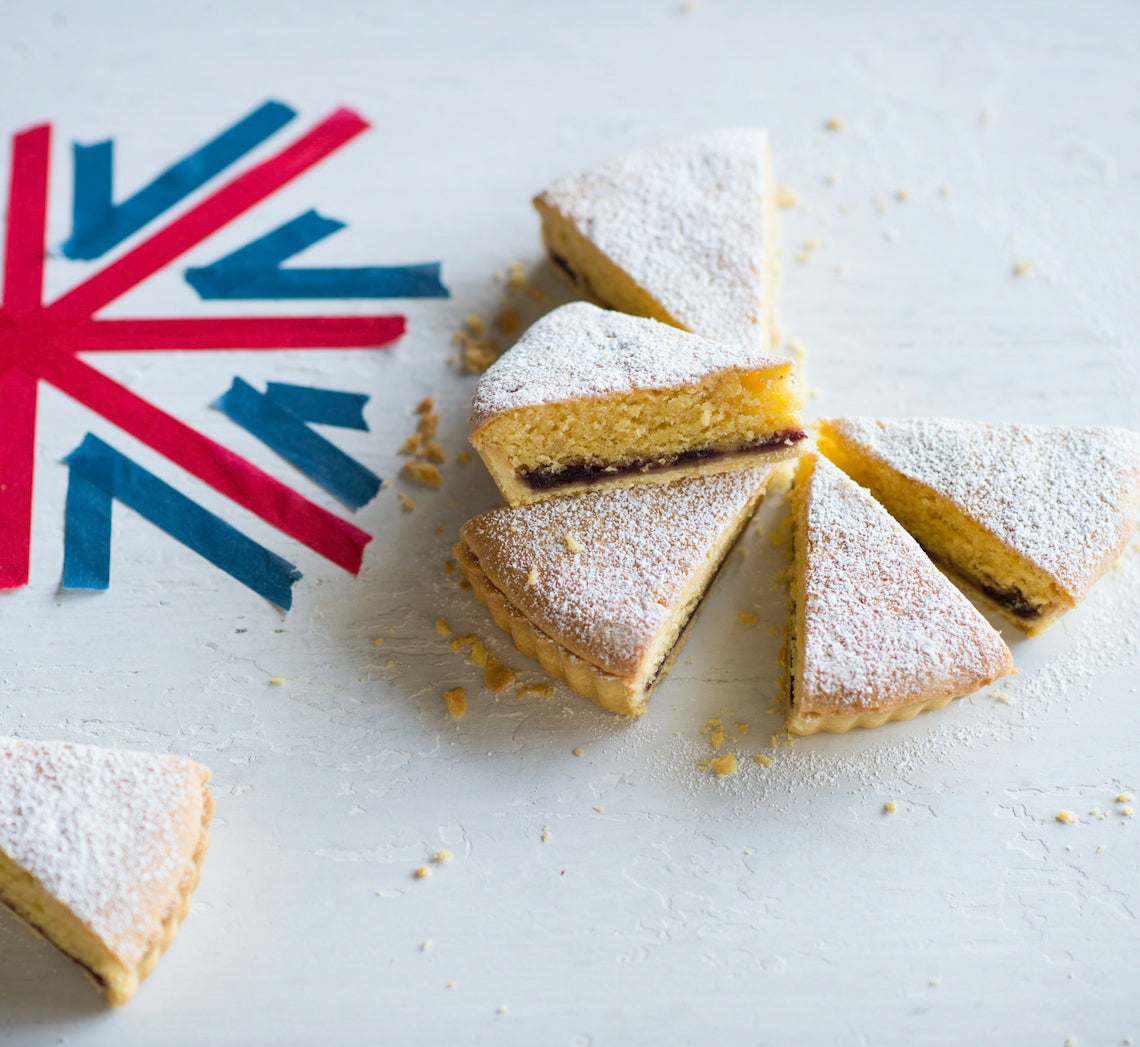
Prep 30minBake 1hr20minMakes about 8-10 serves
Bakewell tart is simply a buttery almond cake in a tart case with a welcome layer of jam in the middle. On first consideration you may not think this combination would work, but take my word for it, it does!
Ingredients
1 quantity sweet shortcrust pastry115g (⅓ cup) raspberry or cherry jam
125g unsalted butter, at room temperature
110g (½ cup) caster sugar
3 drops of almond essence or finely grated zest of 1 lemon
3 eggs
100g (1 cup) almond meal
35g (¼ cup) self-raising flour
icing sugar, to dust
Method
- Preheat oven to 200ºC (180ºC fan-forced).
- Use a lightly floured rolling pin to roll out the pastry on a lightly floured bench top to a round about 3mm thick. Carefully drape the pastry loosely around the rolling pin. Place it over an ungreased round 23cm (base measurement) tart tin with a removable base and then unroll the pastry being careful not to stretch it. Gently lift the edge of the pastry and ease it into the tart tin to line the base and sides and settle it into the corners. Use your fingertips to press it gently into the corners without stretching it. Then, working around the tin, press the pastry into the side using your thumb or finger. Roll the rolling pin over the top of the tart tin to trim any overhanging pastry.
- Place the tart tin on an oven tray. Prick the pastry base with a fork about 12 times. Line the pastry case with baking paper or foil and fill with pastry weights, dried beans or raw rice, making sure they press into the corners and they fill the case. Bake in preheated oven for 15 minutes.
- Remove the pastry case from oven and use the paper or foil to lift the weights out of the case. Return to the oven and bake for a further 15-20 minutes or until cooked through and lightly golden. Remove from the oven.
- Spread the jam evenly over the base of the tart case and set aside. Reduce the oven temperature to 160ºC (140ºC fan-forced).
- Use an electric mixer to beat the butter, sugar and almond essence or lemon zest until pale and creamy. Add the eggs one at a time, beating well after each addition. Combine the almond meal and flour, add to the butter mixture and beat on lowest possible speed until just combined. Spread the mixture evenly over the jam in the tart case.
- Bake in preheated oven for 40-45 minutes or until golden brown and a skewer inserted into the centre comes out clean. Cool in the tin for 10 minutes before removing, dusting with icing sugar and serving warm. Alternatively cool in the tin and serve at room temperature.
Baker's Tips
- This tart will keep in an airtight container at room temperature for up to 2 days.
This recipe is from Anneka's SBS Food online column, Bakeproof: Best of British Baking.
CLICK HERE for more Bakeproof recipes.
Photography by Alan Benson.
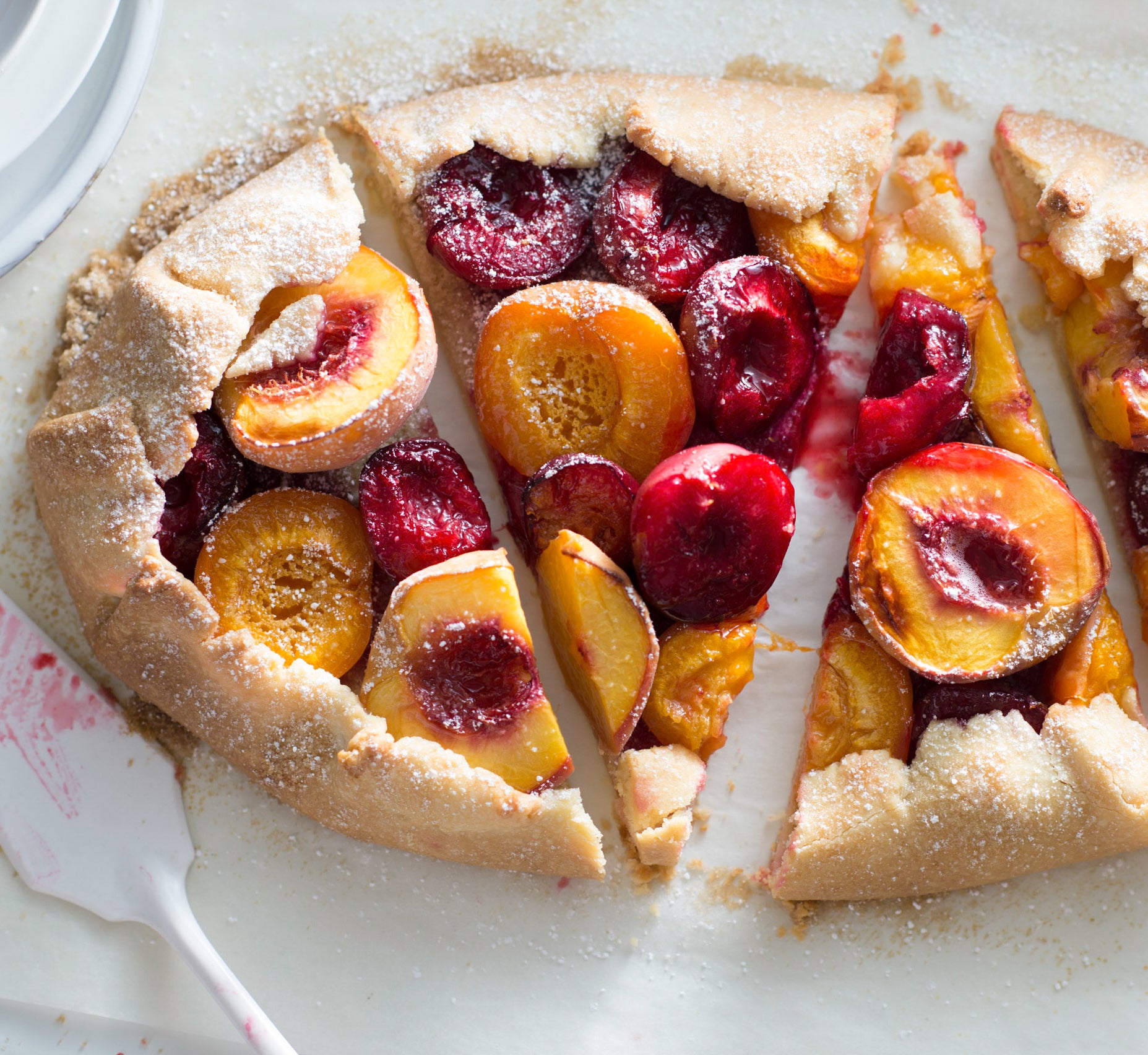
Prep 25min(+ pastry making and chilling time)Bake 50-55minMakes 8-10 serves
This tart is simplicity at its best – a selection of gorgeous summer stone fruit encased in a sweet, easy-peasy pastry. There's no real structure, it's slightly rustic and lets seasonal stone fruits shine. Serve with toffee ice-cream if you can – the combination is sublime.
Ingredients
1 quantity of Sweet Shortcrust Pastry (see Variations)
25g (¼ cup/¾oz) almond meal
700g (1lb 8oz) firm but ripe stone fruit of your choice (such as peaches, nectarines, plums and apricots), halved and pitted
2 tablespoons raw sugar
Icing sugar, to dust (optional)
Good-quality toffee or vanilla ice-cream, to serve
Method
- Preheat oven to 200°C/400°F (180°C/350°F fan-forced).
- Use a lightly floured rolling pin to roll out the pastry on a piece of non-stick baking paper to a rough rectangle about 3mm/⅛in thick. Use the paper to transfer the pastry to a large baking tray. Sprinkle the pastry with the almond meal, leaving a 5cm/2in-wide border around the edge. Arrange the fruit over the almond meal and then fold the pastry border up over the fruit. Sprinkle the upturned border and fruit with the sugar. Bake in preheated oven for 50-55 minutes or until the pastry is golden and crisp.
- Serve warm or at room temperature, dusted with icing sugar, if desired, cut into wedges and accompanied by ice-cream.
Baker's Tip
- This tart is best served warm, but is also great served at room temperature. It will keep covered in the fridge for up to 2 days. Stand at room temperature for about 30 minutes before serving.
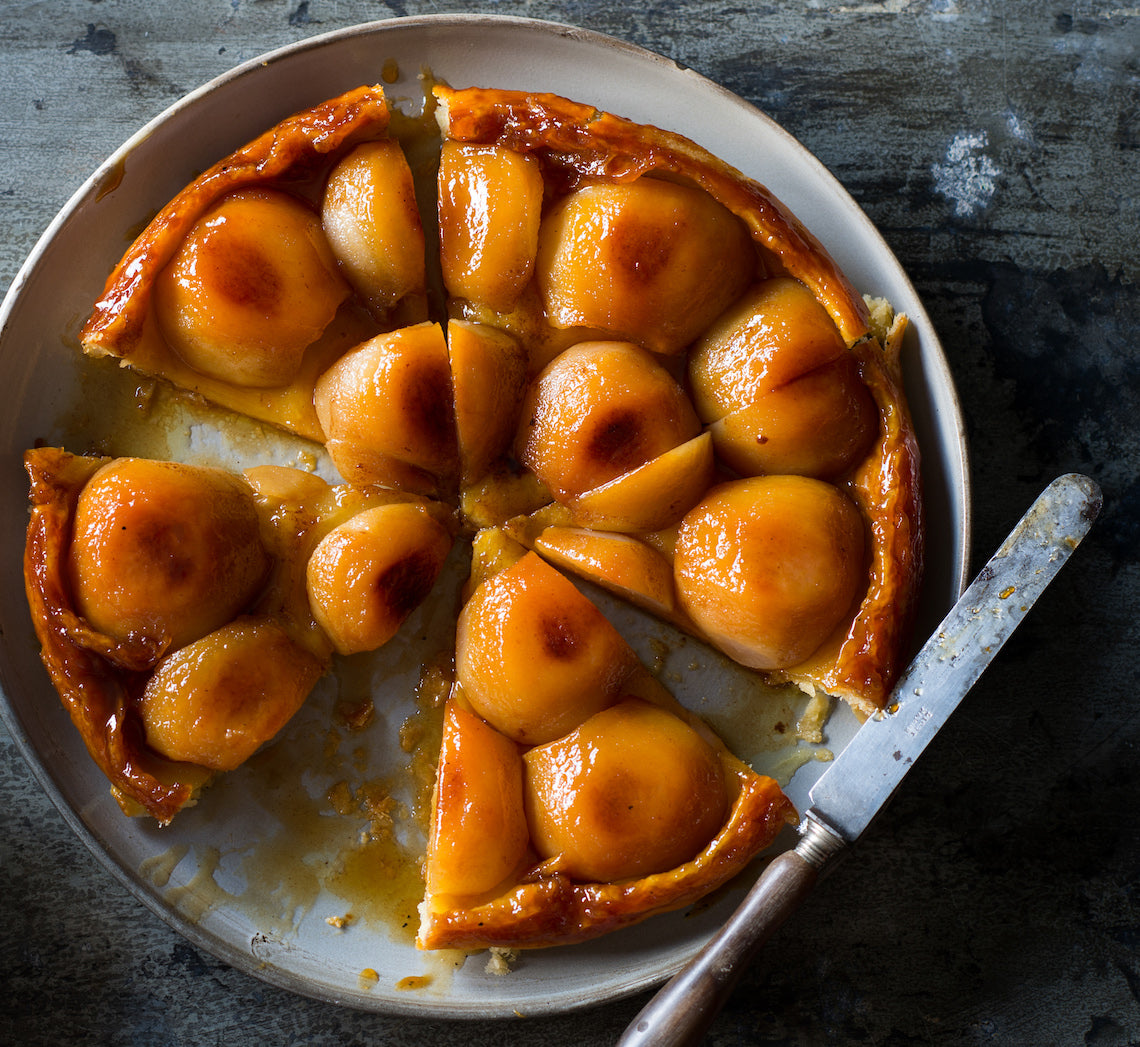
Prep 40min (+20min chilling and 1hr 25min cooling time)Bake 45minMakes 8 serves
Traditionally made with apples, this classic upside-down French tart was created by the Tatin sisters who ran a hotel in France in the early 1900s. If you don't have an ovenproof frying pan, transfer the cooled caramel and pears to a base-lined 22cm round cake tin before covering them with the pastry and baking.
Ingredients
Ground cinnamon, to sprinkle
Vanilla ice-cream, cream or crème fraiche, to serve
1 quantity Shortcrust Pastry
80g (2¾oz) salted butter, cubed
110g (½ cup/4oz) caster sugar
1.1kg (2lb 7oz) small (about 7) pears (such as Josephine), peeled, halved and cored
Method
- Prepare the Shortcrust Pastry.
- Meanwhile, melt the butter in a 20–22cm/8-8¼in(base measurement) heavy-based frypan over medium-high heat. Sprinkle with the sugar and then arrange the pears, cut-side up, in the pan, cutting some of the halves into quarters to fill the gaps. Reduce the heat to medium and cook, uncovered, for 15 minutes or until the liquid becomes a dark caramel and the pears are almost tender and golden underneath. Remove the pan from the heat and set aside for 1 hour 15 minutes or until cooled completely.
- Preheat oven to 190°C/375°F (170°C/340°F fan-forced).
- Use a lightly floured rolling pin to roll the pastry out on a lightly floured bench top to about 5mm/¼in thick and then cut into a circle about 26cm/10½in in diameter. Place the pastry over the cooled pears in the pan and carefully tuck the pastry edge around the fruit and down the side of the pan. Bake in preheated oven for 45 minutes or until the pastry is deep golden and cooked through and the pear juices are bubbling. Remove from the oven and set aside for 10 minutes to cool slightly.
- Place a serving plate with a lip over the top of the tart and invert. Serve immediately cut into wedges and accompanied by ice-cream, cream or crème fraiche.
This recipe is from Anneka's SBS Food online column, The real secrets of French baking.
CLICK HERE for more Bakeproof recipes.
Photography by Alan Benson.

Prep 40min (+30min chilling and 30min cooling time)Bake 20minMakes 12
Dating back almost a century, this Australian creation of a pastry case filled with mock cream (and sometimes a raspberry jam layer) and topped with sickly sweet icing seems to hit a nostalgic chord – we all remember eating them as a child! For a more contemporary twist, we've added an extra colour punch to the pink icing. Remember that chocolate and white, or pink and white are also popular colour combinations.
Ingredients
1 quantity Sweet shortcrust pastry, divided in half before wrapping and chilling as directed
Mock Cream Filling
1 tablespoon boiling water
½ teaspoon gelatine powder
65g (⅓ cup) caster sugar
2 tablespoons milk
125g unsalted butter, softened
1 teaspoon natural vanilla essence or extract
Icing
185g (1½ cups) pure icing sugar
1 tablespoon water, plus 1 teaspoon extra (optional)
2 teaspoons sifted cocoa powder
Pink food colouring
Method
- Unwrap one pastry portion and place on a lightly floured, cool work surface. Gently pat the pastry with the palm of your hand to flatten slightly. Use a lightly floured rolling pin to roll out on a lightly floured surface until 3mm thick. Use an 8cm diameter plain round cutter to cut out 6 circles, re-rolling the pastry if necessary. Line six holes of a 12-hole 80ml ( ⅓ cup) muffin tin (the pastry circles won’t fill the muffin holes completely. Repeat with the remaining pastry portion to line the six remaining muffin holes.
- Prick each pastry case base 3 times with a fork and place in the fridge for 30 minutes. Preheat the oven to 200°C (180°C fan-forced).
- Line each tartlet case with a piece of foil and then fill with dried rice. Blind bake the tart cases for 15 minutes or until the pastry is sealed. Use the foil to lift the rice out of the tartlet cases and bake for a further 5 minutes or until lightly golden and cooked through. Cool the cases in the tin.
- To make the Mock cream filling, put the boiling water in a small ramekin and sprinkle the gelatine over the top. Use a fork to whisk the gelatine into the water and then set aside for about 3 minutes or until the mixture is clear (see Bakers Tips). Meanwhile, combine the sugar and milk in a small saucepan and stir over medium heat until the sugar dissolves. Stir in the gelatine mixture until well combined. Remove from heat and set aside, stirring occasionally so the gelatine doesn't set, for 30 minutes or until cooled to room temperature.
- Use an electric beater to beat the butter and vanilla in a medium bowl until pale and creamy. With the motor running, gradually add the cooled gelatin mixture in a slow steady stream until well combined and fluffy. Divide the Mock cream filling evenly among the pastry cases and smooth the surfaces. Set aside in a cool spot but not in the fridge.
- To make the Icing, sift the icing sugar into a bowl and then stir in the water until smooth (the icing should be a spreadable consistency). Put half the icing into a separate bowl and stir in the cocoa powder and extra teaspoon of water. Colour the remaining portion with 2-4 drops of pink food colouring. Use a palette knife or the back of a teaspoon to spread about a teaspoon of the pink icing over the top of half of each tart. Set aside for 5-10 minutes for the icing to set. Spread about a teaspoon of the chocolate icing over the remaining half of each tart to cover the tops and then set aside for 5-10 minutes for the icing to set. Serve at room temperature.
Baker's Tips
- If the gelatine doesn't dissolve in the boiling water and become clear, add boiling water to a larger heatproof bowl, jug or dish and then sit the ramekin with the gelatine mixture in the water. Stir occasionally until the mixture is clear.
- These tarts will keep in an airtight container in the fridge for up to 4 days. Serve at room temperature.
This recipe is from Anneka's SBS Food online column, Bakeproof: Childhood Favourites. CLICK HERE for more Bakeproof recipes.
Photography by Alan Benson.
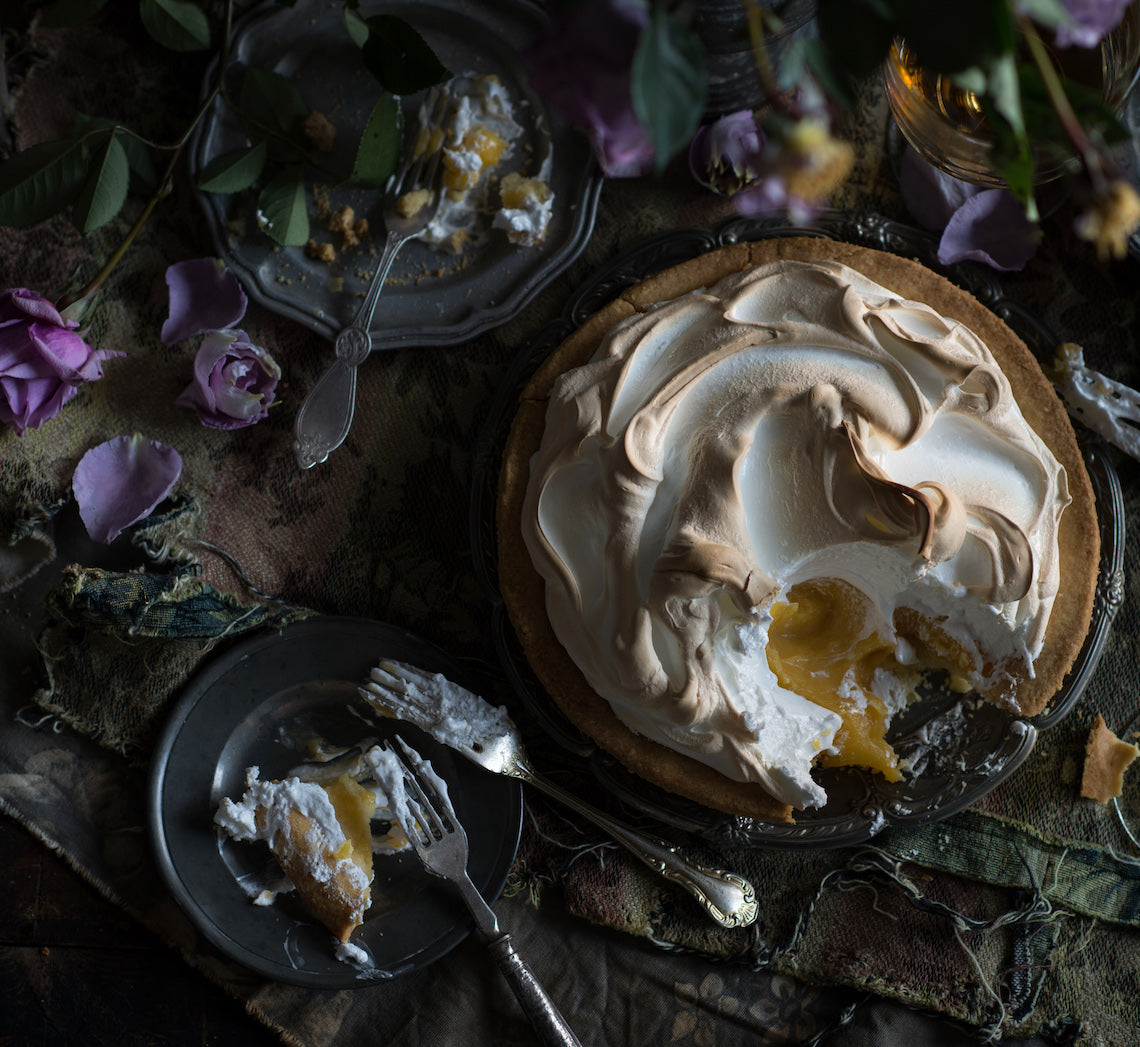
Prep 40min (+pastry making, 30min cooling and 2hr chilling time)
Bake 45-55minMakes 8-10 serves
Sometimes known as lemon chester pudding, lemon meringue pie is a wonderful combination of short, buttery pastry, a tart custard filling and a sweet, fluffy meringue topping. This recipe won’t disappoint!
Ingredients
1 quantity sweet shortcrust pastry, shaped into a disc before wrapping and chilling
Lemon Filling
40g (⅓ cup) cornflour, sifted
200ml strained freshly squeezed lemon juice
80ml (⅓ cup) water
220g (1 cup) caster sugar
6 egg yolks
100g salted butter, diced
Italian Meringue Topping
4 egg whites
220g (1 cup) caster sugar
80ml (1/3 cup) water
Pinch of salt
Method
- Preheat oven to 200°C (180°C fan-forced).
- Use a lightly floured rolling pin to roll out the pastry on a lightly floured bench top to a round about 3mm thick. Line an ungreased 22cm diameter (base measurement), 3cm deep pie plate or tart tin with the pastry. Use a small sharp knife to trim any excess pastry.
- Place the pastry case on an oven tray and use a fork to prick the base about 12 times. Line the pastry case with crumpled baking paper or foil and fill with pastry weights or raw rice, making sure they fill the case. Bake in preheated oven for 20 minutes.
- Remove the pastry case from the oven and use the paper or the foil to lift the weights out of the case. Return the case to the oven and bake for a further 20-25 minutes or until the pastry is cooked through and is golden. Set aside to cool.
- To make the Lemon Filling, place the cornflour in a medium saucepan. Use a balloon whisk to gradually stir in the combined lemon juice and water until smooth and well combined. Stir in the sugar, egg yolks and butter. Stir over medium heat for 3-5 minutes or until the butter melts. Continue to stir over medium-low heat for 5-10 minutes or until the mixture thickens and comes to a simmer. Pour immediately into the pastry shell and use the back of a metal spoon to smooth the surface. Set aside for 30 minutes to cool. Cover and chill for at least 2 hours or until the filling is set.
- When ready to serve, preheat oven to 240°C (220°C fan-forced).
- To make the Italian Meringue Topping, put the egg whites in the bowl of a stand mixer fitted with a whisk attachment. Combine the sugar and water in a small saucepan and stir with a wooden spoon or spatula over low heat until the sugar dissolves. Increase the heat to medium and bring to the boil. Boil for about 10 minutes, occasionally brushing down the side of the pan with a pastry brush dipped in water to dissolve any sugar crystals, until the syrup reaches soft ball stage (115°C on a sugar thermometer). Meanwhile, just before the syrup is ready, whisk the egg whites on high speed until firm peaks form. Remove the syrup from the heat and stand for about 1 minute or until the bubble subside. With the motor running on high speed, gradually add the sugar syrup in a thin steady stream until all the syrup has been incorporated. Add the salt and then continue to whisk on medium speed for another 10 minutes or until the meringue has cooled to room temperature.
- Spread the meringue mixture over the top of the lemon filling, swirling as desired. Bake in preheated oven for 5-10 minutes or until browned on the edges (see Baker’s Tips). Stand for 5 minutes before scooping with a large metal spoon or cutting into wedges with a sharp knife that has been dipped in hot water (see Baker’s Tips).
Baker's Tips
- This pie is best eaten the day it is made.
- If using a tart tin, you can transfer the pastry case to a ovenproof serving plate before adding the filling.
- You can also use a blowtorch to caramelise the meringue topping instead of returning it to the oven in step 7.
- Dipping the spoon or knife in hot water and drying before scooping or cutting will make it easier to portion.
This recipe is from Anneka's SBS Food online column, Bakeproof: Citrus.
CLICK HERE for more Bakeproof recipes.
Photography by Alan Benson.
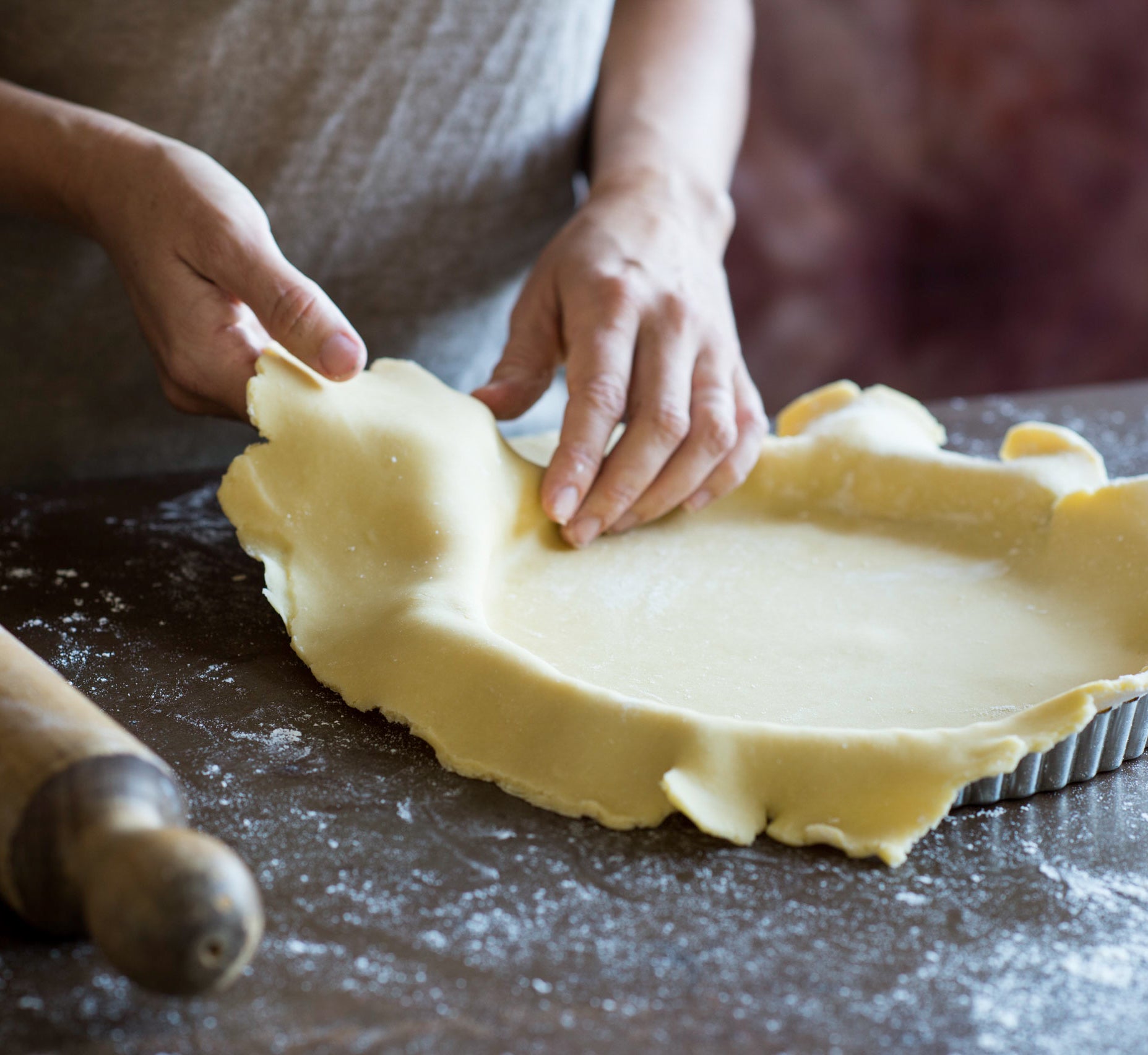
Prep 15min (+20-30min chilling time)Makes: Enough for a 23cm/9in round tart case
A really good, well-made, homemade pastry is always the secret to a fabulous pie or tart and shortcrust pastry, when you have a good recipe, is one of the simplest and quickest pastries to make. Here I have given lots of making ahead and freezing tips as well as some great variations to use in a selection of both sweet and savoury tarts and pies.
Ingredients
225g (1½ cups/8oz) plain flourGood pinch salt
150g (5¼oz) chilled unsalted butter, diced
3-3½ tablespoons (60-70ml/2½fl oz) iced water
Method
- Combine the flour and salt in a large, wide mixing bowl. Add the chilled butter. With your palms facing upwards, use your fingertips to rub in the butter until the mixture resembles breadcrumbs with some larger pieces of butter still visible.
- Sprinkle 3 tablespoons (60ml/2fl oz) of the iced water over the flour and butter mixture. Use a butter or round-ended knife in a cutting motion to mix, turning the bowl frequently, until evenly combined and the mixture starts holding together. Press a little of the mixture between your fingers – if it holds together easily, there is no need to add more water; if it doesn’t add the remaining 1⁄2 tablespoon (10ml/⅓fl oz), a teaspoon at a time, combining with the knife until it reaches the right consistency. The pastry should be soft but not sticky.
- Bring the pastry together with your hands in the bowl or turn out onto a cool bench top and then bring together. Lightly knead the pastry with your fingertips for about 5-10 seconds or until it comes together but isn’t completely smooth. Shape the pastry into a disc about 2cm/¾in thick, wrap well in plastic wrap, baking paper or beeswax wrap and place in the fridge for 20-30 minutes to rest. Use as directed.
Baker's Tips
This pastry is also enough for a 24cm/9½in square tart case; ten 6cm/2¼in or eight 8cm/3¼in) individual round tart cases; a 12cmx34.5cm/4¾inx13½in) rectangular tart case; or 24 tartlet cases (1 Tbsp/20ml/¾fl oz capacity)
Making Ahead
Keeping in the fridgeShape uncooked pastry into a disc. Wrap well in plastic wrap and keep in the fridge for up to 3 days. Stand at room temperature for about 1 hour (depending on the temperature in your kitchen) until softened slightly and pliable enough to roll easily.
Freezing uncooked pastry
Shape uncooked pastry into a disc. Wrap well in plastic wrap, then seal in a freezer bag or airtight container and freeze for up to 6 months. Transfer to the fridge to thaw completely (this will take about 1 day). Stand at room temperature for about 1 hour (depending on the weather) until softened slightly and pliable enough to roll easily.
Freezing uncooked pastry case/s
Place the pastry case, still in the tin or dish, in the freezer until frozen. Once frozen, leave the pastry in the tin or dish or remove and seal in freezer bag or an airtight container. Freeze for up to 6 months. Bake in the tin or dish directly from the freezer or transfer to the fridge to thaw completely in the tin or dish (this will take about 1 day) and then bake as directed.
Variations
- Rich Shortcrust Pastry: Increase the butter to 170g (6oz). Replace the water with 1 lightly whisked egg yolk.
- Parmesan Shortcrust Pastry: Combine 40g (½ cup/1½oz) finely grated parmesan to the flour and butter mixture just before adding the water.
- Mustard Shortcrust Pastry: Add 1½ teaspoons dry mustard powder to the flour and salt before rubbing in the butter.
- Sweet Shortcrust Pastry: Stir 2 tablespoons sifted icing sugar or caster sugar to the flour and butter mixture just before adding the water.
- Chocolate Shortcrust Pastry: Reduce the flour to 200g (1⅓cups/7oz). Sift the flour with 2 tablespoons cocoa powder and 2 tablespoons icing sugar and the salt before rubbing in the butter.
- Sweet Orange & Vanilla Shortcrust Pastry: Reduce the flour to 200g (1⅓cups/7oz). Add 2 tablespoons almond meal, 2 tablespoons caster or icing sugar and 1 teaspoon finely grated orange zest to the flour and salt before rubbing in the butter. Add 1 teaspoon natural vanilla essence or extract with the water.
This recipe is from Anneka's SBS Food online column, Bakeproof: Never-fail Shortcrust Pastry. CLICK HERE for more Bakeproof recipes.
Photography by Alan Benson.






